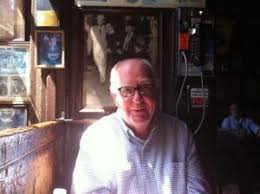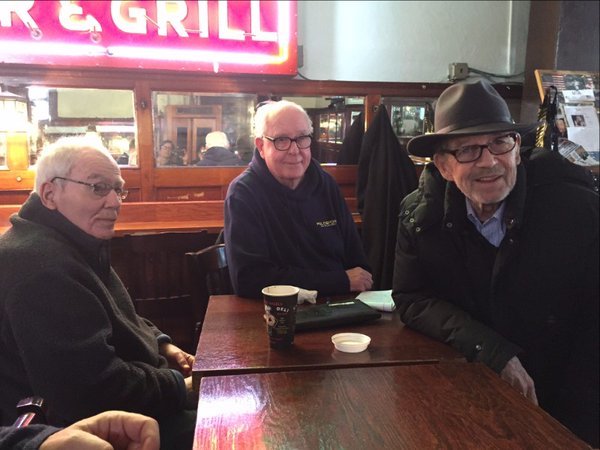It was January 22 of 2019 and I was standing in this large room at the Time Warner Center in Manhattan. The room overlooked Columbus Circle. There was a cocktail party going on and as I looked around at the guests coming in I could see all these faces that I usually only see on television, or in their words as by-lines on the pages of New York’s newspapers.
Some of them like Phil Donahue were from another time, a time that seemed so long ago now. And there was Dan Rather and Gay Talese, and Ken Auletta who wrote those long scholarly stories for the New Yorker. And there were comedians there too. Robert Klein was one of them.
A lot of small talk was going on as the room started to fill up. Someone said that Gary Trudeau who does the Doonesbury cartoons was there.
They were all there for the premier screening of “Breslin and Hamill: Deadline Artists,” a HBO documentary by Jonathan Alter which is probably one of the most important films of our time about who we once were in journalism in New York, who we once were in America, a lost time that Pete Hamill and Jimmy Breslin caught so well in their daily writing about ordinary people, over and over again.

Earlier when I walked into the lobby of the building, I stopped to thank Jonathan Alter for inviting me and my wife Patricia. We talked briefly and he told me that unfortunately, they had to cut out the entire segment with Pete and Jimmy that was shot in Farrell’s Bar in Windsor Terrace, Brooklyn. He told me that there was just so much material and they had no room for the Farrell’s segment, so it didn’t make it.
I was there on the afternoon they shot it and looking around the cocktail party now I wondered what the media personalities in the room would have thought about it, what would Gary Trudeau have thought about it? Farrell’s bar was such a different world from the one we were in now at the cocktail party.
One of the owners of the bar, Jimmy Houlihan, had called me up the night before the Farrell’s bar segment and asked me if I wanted to come down and write something about it. And of course, I said yes, and when I got to the bar, I was surprised to find that I was the only writer there covering it.
I remember watching Pete Hamill as he sat on a high-backed bar chair staring towards the wide front window out onto 9th Avenue, an avenue of Windsor Terrace, Brooklyn that he had walked on over so much of his life. It once led everywhere for him. The history of his life was out there.
Sitting in front of him, facing him, was Jonathan Alter. He was there with another producer Steve McCarthy from McCarthy Productions to shoot the segment.
This was on a Sunday morning in the spring of 2016. As a writer taking it all in, I didn’t plan on being in it, but toward the end of the shoot, which went on for about four hours. Jonathan Alter asked me if I would go on camera and talk about Pete Hamill and Windsor Terrace. Pete had introduced me to him earlier.
I told him I would, but it got me thinking of all my memories there. Farrell’s, like all old bars that are still around, hold the memories of years, of decades, the personal memories of anyone who watched years go by in them. You just walk into one of them again and time and memories come flooding back to you.
Thinking back on my memories, my time in Farrell’s when I was young; it seemed strange to be even standing there now with a notebook and pen in my hand taking notes on a film being produced about a place, a bar that once defined a part of me. And soon those notes would turn into a story with my byline on it. And as I looked toward the long row of old, thick glassed mirrors behind the bar, still there after all these years, I could almost see that person again. I was just 18, working on garment trucks in the city with my friend Bob Rice, the two of us, high school dropouts, working minimum wage, pushing dress racks down traffic crowded 7thAvenue, having no idea where our lives were headed, and not really worried about it. Most of our days then were like a scene out of Sillitoe’s “Saturday Night and Sunday Morning.” We drank our fill of pints on weekends, slow danced in one of the bars further down the avenue, and then come Monday it was up and off to the grind again.
“What music do you associate with your years drinking in Farrell’s,” Jonathan Alter asks Pete Hamill as the camera rolls. “Early Rock and Roll” he answers. And I’m thinking, what a beautiful, answer, “early Rock and Roll.” And I think of Johnny Ray leaning into a microphone and singing “Cry”, and Ivory Joe Hunter singing “Since I met you Baby.”

The bar starts to crowd up now as the Sunday noon hour comes on. Jimmy Breslin walks in and makes his way past Pete and Jonathan Alter as he carefully walks across the cables that line the floor. I walk with him to the back of the bar, and we sit down at a pub table.
And as I look over toward him, I think of other bars and other places I once sat with him. One early summer morning long ago in the early 70s we sat together in the back of the Pastrami King on Queens Boulevard, before it opened. Moishe, the owner opened the door for him. And right away Jimmy said to him in a loud voice, “Get us some coffee and a bowl of those rugelach things, Moishe. ” And we talked about writing, talked about something he wanted to work with me on for a TV pilot after reading a long New York Magazine piece I wrote about working at the airport as a cargo handler, “Confessions of a Working Stiff.”
I think of another afternoon with him in a bar on the edges of Kennedy Airport on the corner of Farmer’s Boulevard, “The Owl.” It was a wise guy bar, but I spent time drinking there when I worked at JFK. Some say that the Lufthansa heist was planned there. All the excitement of those times and places were gone from his face today. Once, when he was a younger man, long, black hair tumbling over his Irish forehead, he would stroll into Farrell’s bar with the slow gate of a celebrity. And he would always leave with a newspaper column.
One of the directors signal back to him that they want to have him sit next to Pete so they can do an interview with the two of them together. And there they are, two of the greatest newspaper reporters in America, Jimmy Breslin and Pete Hamill, two of the last legends of that fading business sitting side by side in one of the last Irish working-class saloons left in Brooklyn.
When the cameras stopped running, they slid off of the chairs and made their way through the crowd that filled the back of the bar now. And as they pushed through it the cameras started up again and filmed it all. They each stopped along the way as overhead lights hovered over them, boom mics dipped down and answered any questions asked of them by the crowd, a last literary hurrah of sorts of two great writers.

Whatever footage was shot there that afternoon by Jonathan Alter will one day be part of a lost story about a time when newspapers once told the stories of who we were; not who we should be. All that gone now. ♦
If anyone has information about the lost footage please contact Irish America at submit@irishamerica.com
On Thursday, June 24, 2021 Pete Hamill Way was dedicated in Park Slope, Brooklyn at the corner of 7th Ave and 12th Street. June 24th is Pete’s birthday, what a wonderful posthumous birthday gift for Pete.

Pat Fenton grew up in Windsor Terrace in Brooklyn, and worked as a court officer. He has written for a number of publications, including his popular piece on Farrell’s Bar for Irish America. He also wrote a play, “Stoopdreamer,” about the historic Irish saloon. He new book, Searching for Harry Chapin’s America” Remember When the Music, will be released on July 16, 2021.


Having grown up in Brooklyn New York in the 60s and 70s Breslin and Hamill two of my favorite to read. I just completed reading Pat’s book searching for Harry Chapin America. I am a big fan of Harry Chapin and thoroughly enjoyed this book. I also remember as a kid listening to people say Breslin for president. Good memories.